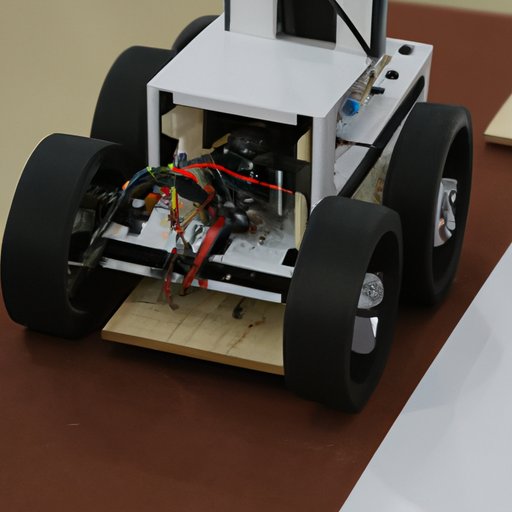Introduction
Robots are everywhere. They can be found in factories, hospitals, homes, and even outer space. But what exactly is a robot? This article will explore the definition of a robot, its components, types, technology, history, and benefits. By the end of this article, you’ll have a better understanding of what makes a machine a robot.
Exploring the Definition of a Robot
A robot is defined as “a machine that looks like a human being and performs various complex acts (such as walking or talking) of a human being” 1. It is an intelligent machine designed to carry out a variety of tasks with minimal human intervention. It is capable of sensing its environment, making decisions, and carrying out actions accordingly.
Robots are used in a variety of applications, from manufacturing and healthcare to search and rescue and home automation. They have become invaluable tools for businesses, allowing them to maximize efficiency and reduce costs.
Examining the Components of a Robot
A robot consists of several components, including mechanical parts, electrical parts, and computer programming.
Mechanical Parts
The mechanical parts of a robot are responsible for its physical structure and movement. These parts include arms, legs, joints, motors, and actuators. The arms and legs provide the robot with mobility, while the joints give it flexibility. Motors and actuators enable the robot to move and perform specific tasks.
Electrical Parts
The electrical components of a robot are responsible for powering the robot and providing it with control signals. These components include batteries, switches, circuit boards, transistors, and sensors. The batteries provide power to the robot, while the switches, circuit boards, and transistors control the flow of electricity. Sensors are used to detect changes in the environment and send signals to the robot’s control system.
Computer Programming
Computer programming is essential for robots to function. It enables the robot to interpret the data received from its sensors and make decisions based on that data. It also allows the robot to carry out predetermined tasks autonomously.

Investigating the History of Robotics
The origins of robotics can be traced back to ancient Greece. The Greek engineer Hero of Alexandria described a device he called a “programmable cart” which was capable of following a predetermined path. In the 20th century, the development of robotics accelerated rapidly. In 1954, George Devol invented the first programmable robot, and in 1961 MIT professor Joseph Engelberger developed the first industrial robot. Since then, robots have been increasingly used in industry, medicine, and other fields.

Analyzing the Technology Behind Robotics
Robotics is powered by a number of technologies, such as sensors, artificial intelligence, and motion control.
Sensors
Sensors are used to detect changes in the environment and send signals to the robot’s control system. Examples of sensors include cameras, microphones, infrared sensors, and sonar.
Artificial Intelligence
Artificial intelligence (AI) is a branch of computer science that deals with the simulation of human intelligence processes. It enables robots to learn from their environment and adapt to new situations.
Motion Control
Motion control is the process of controlling the motion of a robot. It involves the use of computers to control the speed, direction, acceleration, and deceleration of a robot’s movements.
Looking at the Different Types of Robots
Robots can be classified into three main categories: industrial robots, service robots, and autonomous robots.
Industrial Robots
Industrial robots are robots used in industrial settings. They are typically used for repetitive tasks such as welding, painting, and assembly.
Service Robots
Service robots are robots used to provide services to people. Examples include robotic vacuum cleaners, lawn mowers, and medical robots.
Autonomous Robots
Autonomous robots are robots that can operate independently without direct human control. Examples include self-driving cars and drones.

Discussing the Benefits of Robotics
Robots offer a number of benefits, including improved efficiency, increased productivity, and reduced risk. According to a study by the International Federation of Robotics, “Robots can increase output by 25 percent, reduce production costs by 30 percent, and improve product quality by up to 90 percent” 2. Additionally, robots can reduce the risk of injury by performing dangerous tasks in hazardous environments.
Evaluating How Far We’ve Come in Robotics
Robotics has come a long way since its inception. Today, robots are used in a variety of industries, from manufacturing and healthcare to search and rescue and home automation. As technology continues to advance, robots will become increasingly sophisticated and capable of performing more complex tasks.
Conclusion
This article explored what makes a machine a robot, examining the components, types, technology, and history behind robotics. We learned that robots consist of several components, including mechanical parts, electrical parts, and computer programming. Furthermore, we discussed the different types of robots, as well as the benefits they offer. Finally, we evaluated how far we’ve come in robotics and what the future may hold.
(Note: Is this article not meeting your expectations? Do you have knowledge or insights to share? Unlock new opportunities and expand your reach by joining our authors team. Click Registration to join us and share your expertise with our readers.)
